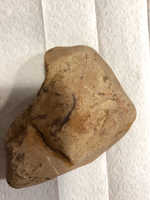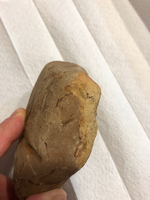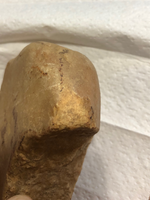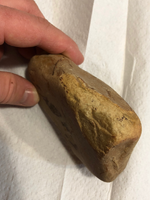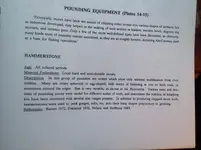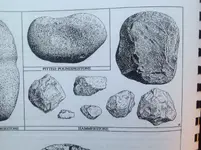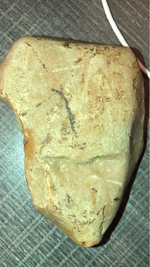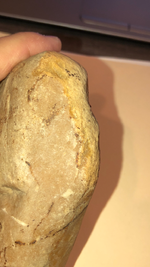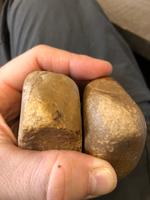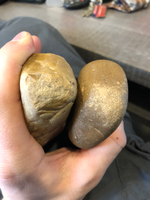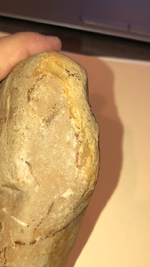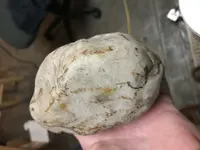Howdy BobGuy, this is an interesting, and nice example for the questions you've raised, and the discussions we are having regarding quartzite cobble hammerstones. The telltale signs I see that make me believe this is most likely not a quartzite hammerstone are thus. Charl has posted some very nice photos of classic quartzite hammerstones. On those examples you can see the difference in patina between the smooth and very ancient cortex of the cobble, and the also ancient patina showing on the rough surface where the hammerstone tool was used by pre-historic peoples. Even where the tool was used it has a duller looking patina, as opposed to the fresher and much brighter yellowish patina that shows where the cortex was removed from your example. On Charl's nice examples you can also see where all the little use/wear chips are about 1/4" diameter or considerably less. This was intentional as the pre-historic peoples took due care not abuse their hammer and grindstones, especially on food applications where stone dust & chips are not desirable in foods. On Charl's fine examples you can also see how there are no sharp angles or edges produced by the use wear, as found on your example. Your example shows sharper angles and evidence of fingernail size or larger chips removed from the cortex. Large flake removal like this can be found purposely made on large stone chopping tools, but shouldn't be there on hammer or grinding stones unless as signs of unintentional damage. I do not believe that anyone has been suggesting that your example is a chopping tool.
I do agree with you and others that the chips as shown on your example could be produced by people hammering your stone against another stone, or by hammering another stone against yours. I believe I could pick up a quartzite cobble of similar shape and size and remove similar chips my humble self. The significant part I believe is in why they were doing it, what was the possible purpose for chips being removed the way they are? I believe it more plausible that chips like that were due to a person picking up that quartzite cobble and hitting it a few times to check it suitability for flake removal, or chipped tool production, rather than use wear from a hammering or grinding job, but again the lack of any significant patina where the flakes have been removed, preclude me from going too far down that path.
The other thing that I believe needs to be strongly considered are the telltale brown implement scraping marks that seem to point directly to the implement scraping along the edge of this rock until it got near enough to the edge that a chip would break off, They look to lead right to it from each angle the chips were made.
We all make up our own minds on whether or not items are artifacts or not, and what meets our own collecting passions, that is half the fun of it, and the way it should be IMO. You did the right thing by asking for opinions and thoughts, and we are all just happy to chime in, it is all good. HH
